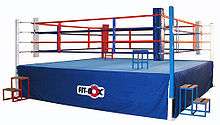Boxing ring

A boxing ring is the space in which a boxing match occurs. A modern ring, which is set on a raised platform, is square with a post at each corner to which four parallel rows of ropes are attached with a turnbuckle. Unlike its cousin the wrestling ring, the ropes in a boxing ring are generally connected together between the posts.
Construction
As there are a number of professional boxing organizations, the standards of construction vary. A standard ring is between 16 and 20 feet (4.9 and 6.1 m) to a side between the ropes with another 2 feet (0.61 m) outside. The platform of the ring is generally 3 to 4 feet (0.91 to 1.22 m) from the ground. The ring itself has around 1 inch (25 mm) of padding covered by stretched canvas. The ropes are around 1 inch (25 mm) in diameter and at heights of 18, 30, 42, and 54 inches (.46, .76, 1.07, and 1.37 m) above the mat, held up on posts rising around 5 feet (1.5 m) above the mat,
Terminology
The name "ring" is a relic from when contests were fought in a roughly drawn circle on the ground. The name ring continued with the London Prize Ring rules in 1743, which specified a small circle in the centre of the fight area where the boxers met at the start of each round. The first square ring was introduced by the Pugilistic Society in 1838. That ring was specified as 24 feet (7.3 m) square and bound by two ropes. For these and other reasons, the boxing ring is commonly referred to as the "squared circle".
See also
References
- "Equipment–Ring". AIBA. Retrieved January 10, 2013.